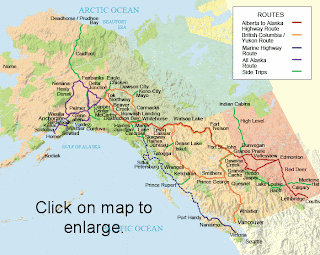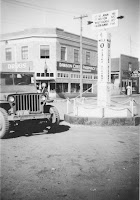.JPG) After 25 days on the road our chalet on wheels has come to rest at our Bellevue home. It was a 5000 mile journey touching two states and two Canadian provinces with six border crossings. The weather was a bit cooler than we’d planned and some parks were not open for the season but, on the other hand, it kept the bugs and crowds down.
After 25 days on the road our chalet on wheels has come to rest at our Bellevue home. It was a 5000 mile journey touching two states and two Canadian provinces with six border crossings. The weather was a bit cooler than we’d planned and some parks were not open for the season but, on the other hand, it kept the bugs and crowds down.
Dawson Creek was the official end of the Alaska Highway making the next three days of the trip a bit anti-climatic. However, the last 800 miles through spectacular southern British Columbia was worth the trip.
.JPG) |
| The Outdoor Pools at Harrison |
As a reward for “roughing it” we stopped at Harrison Hot Springs Resort & Spa for the last night on the road. The resort is a classic and, in my mind, for “old people” who want to bath in mineral waters. I was wrong. Several new wings have been tastefully added to the original hotel and the place was hopping with families enjoying Canada’s first three day weekend of the summer season (Victoria Day.)
.JPG) |
| The View from the Hotel |
With three outdoor and two indoor pools (including adult only offerings) we soaked away the grit and grime of four weeks on the dusty trail before wandering into the small town for dinner. First stop was highly rated Morgan’s Bistro. The food may be good but the flustered lady in charge was in a bit of a snit and decreed that, “we are not seating anyone else at this time.”
So it was down the street to the Black Forest Steak and Schnitzel for a bit of German food. We had an excellent meal and were able to sit outside with a view of Harrison Lake, just across the narrow road.
I’m not a fan of hotel breakfast buffets so the next morning we escaped to a small local place that was just right. Cookin’ Kim’s Country Café had all the breakfast standards and then some.
It was then time to point the car south, into the Washington rain for the last leg of the trip.
Now there is nothing left but the memories and a chance to reflect on the trip—what went per plan, what would be do different and so on. That reflection can await for another day. For now it’s sort mail, get organized and get back to the normal stuff of home. We shall see how quickly we can adjust.

.JPG)
.JPG)

.JPG)




.JPG)
.JPG)
.JPG)











.JPG)
.JPG)
.JPG)
.JPG)
.JPG)
.JPG)
.JPG)
.JPG)
.JPG)


.JPG)
.JPG)

.JPG)
.JPG)
.JPG)

.JPG)
.JPG)
.JPG)
.JPG)
.JPG)
.JPG)